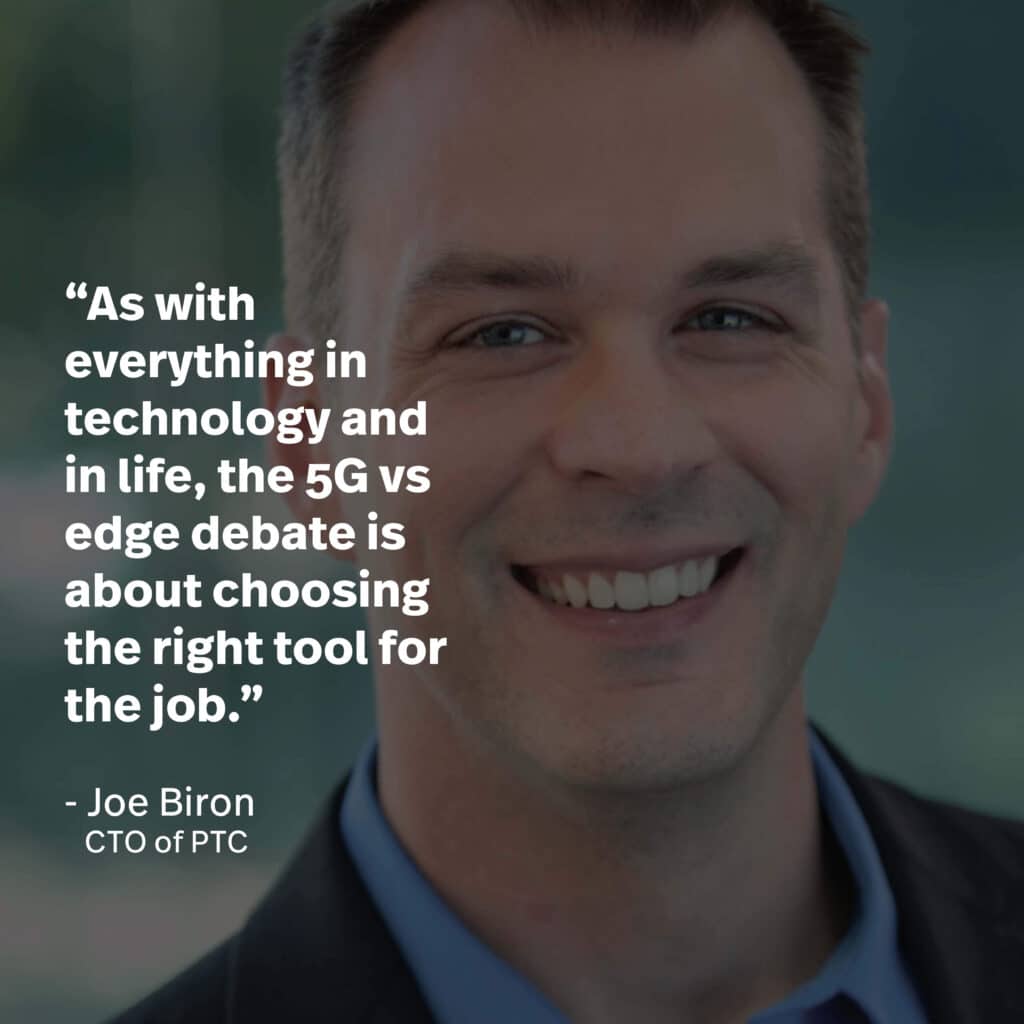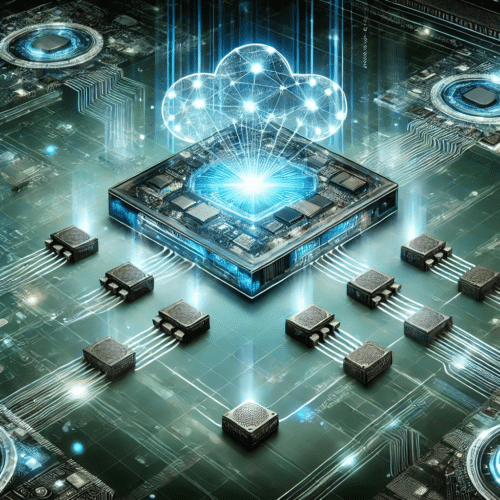BLOG
5G vs. Edge: Point-Counterpoint with Forrester & PTC
What does edge computing mean in the 5G era, and how can enterprises make the right technology choices for their IoT and IIoT initiatives?
During Connected Things 2020: WFH Edition, Very partnered with MIT Enterprise Forum Cambridge to bring together industry leaders to speak about the topic. Watch the video here:
Introducing the Panelists

Moderator: Mark Thirman, Board Member, MIT Enterprise Forum
Mark has over 30 years of experience in executive roles gathered in a broad range of telephony, infrastructure, and networking companies.

Frank Gillet, VP and Principal Analyst at Forrester
With close to 25 years of experience analyzing technology and market trends, Frank has a lot of fun helping people understand emerging technologies and how new tech will impact their businesses.

Joe Biron, CTO of IoT at PTC
As a computer scientist and software engineer turned CTO and industrial IoT evangelist, Joe often describes himself as a technologist that has sympathy for the business.
5G vs Edge: Setting Up the Conversation
To begin, Mark asked Frank and Joe to talk broadly about 5G and the edge, respectively. How do we define each technology, and what are the benefits of each? Is a conversation about the edge and 5G always an either/or question for enterprises?
Exploring the Real Value of 5G
Frank began by delving into the benefits of 5G:
Frank: To frame it up for our audience – when you have to create a connected thing, you always have to choose the connection for your device. But then right after you choose the connection, your next question is: how much compute do I put on the thing? We are coming out of a 10-15 year period where the assumption was, you put skinny compute on there because it all belongs in the cloud. And now, there’s this trend that Joe will talk to us about that says you need to put compute at the edge.
The actual, basic breakdown of 5G is that it’s supposed to offer higher bandwidth, lower latency, and reduced costs, and use less energy (and therefore require less battery).
It should also be noted that 5G is not the only option in this area. In addition to 5G, there’s a wide range of forms of low-power wide-area technologies that are promising similar, if not exactly, the same benefits of 5G over whatever the options are today for improving the wide-area connectivity to your devices.
Also, another intrinsic benefit of 5G is that if you get your connectivity from a carrier, they do all the management of the connection, so you don’t need to worry about tuning and managing WiFi locally in your environment. In effect, you’re outsourcing the management of the network and just making it simpler to deal with connectivity.
When and Where to Use Edge Computing
If the benefits of 5G are as great as everyone says, where should adding compute power to the edge come into play, if at all? Joe addressed the question first.

Joe: I think that as always, as with everything in technology and in life, it’s about choosing the right tool for the job. First, IoT is a fundamentally distributed architecture, That’s principle number one. By its very mission, a connected device has some intelligence, at least enough intelligence to liberate the necessary signals from an asset or an environment and apply security and transmission to that data so that it can be sent to a backend system. So because there is that intelligence at the edge, even if it’s insect-level intelligence by modern standards, it’s fundamentally distributed.
If there’s a slider that we can move between “everything happens in the cloud” versus “everything happens at the edge,” that slider should never be at the absolute end of either one of those poles. The trick to a successful implementation is choosing that slider position and understanding the pros and cons of putting it there. For example, it could be compelling to say, “We would like to do machine learning training and scoring at the edge, because we’ve got all this data in a factory, and we don’t want to have to move all of the data to the cloud to do that.” In this setting, you don’t have to worry about things like latency, or even debate latency versus bandwidth, because it’s all happening on-premise, with probably a hundred-gigabit Ethernet interconnect.
Considerations for Retrofitting the Edge
The edge vs. 5G conversation particularly comes into play for manufacturers looking at potentially retrofitting edge devices with IoT capabilities. Joe and Frank discussed the implications of both technologies in this scenario.

Frank: One of the interesting things about the edge is to what extent you can retrofit the edge. There’s the hardware question, but I think even more important is the software architecture question. Can you really take a hunk of software that was built to run on the cloud and break it into pieces and distribute it? If you’ve engineered that flexibility into the software, however, then you get some choice. So, one argument for improving the connectivity is that you can get the benefits of the cloud without having to rethink your hardware and your distributed software architecture. Just amp up the bandwidth.
Joe: Bandwidth could be the magical elixir. The reality of 5G, though, is when it’s completely deployed, we’re going to see these little boxes at street level, every hundred meters. They’re not there yet – they’re coming – but not there yet. When they do arrive, there will be some huge benefits. The latency is low, so there’s not a whole lot of air to push through the garden hose. The bandwidth is much better than LTE. Better than probably my broadband where I’m standing right now. What’s really cool as well is the network slicing, in the quality of service. So if I can say for this workload, this is the quality of service I want to dial in from my 5G provider, and I can be guaranteed to the extent physically possible that I can get that quality of service, that’s pretty great. All those things are possible today with LTE, but the provisioning cycle and the billing cycles weren’t necessarily designed with the IoT use cases in mind.

Frank: No, because they haven’t really rolled out the IoT specific offerings in-depth and full capabilities yet. The other thing I want to explore here is that it’s clear that there’s an advantage over LTE when 5G becomes available in your area. Two notes – one is the private deployment idea. Why wait for the telecommunications companies to set up a private deployment in your facility? Number two – sometimes you hear the quality of service network slicing argument over WiFi. Of course, there are ways of prioritizing your traffic over a WiFi network, but then you have to have the skills and manage that. Whereas the idea for 5G is that it’s a built-in feature. The telecom company gives you the option, you check the box, you’re done.
With the deployment argument, one thing we also need to keep in mind is that there are three flavors of 5G:
- Low band
- Mid band
- High band
One of the things to think about if you’re leaning on 5G is what kind of connectivity you will have in your area. Will you have the long-range low band that you’re probably going to see in rural areas? Are you going to have the more typical mid band stuff you’ll see widely in metro areas? Or will you only have millimeter wave in places where they can justify doing block-by-block transmitters?
My question is: if you’ve got the great 5G stuff, and you’re in downtown Chicago, why on earth would you ever do edge if you’ve got 5G millimeter wave and a great line of sight to the antenna?
Joe: Yeah, well the question is how much edge. With fundamentally distributed architecture, there will always be an edge. The question is whether it’s going to be a Raspberry Pi or an HPE Edgeline 4000, and what’s the right workload for that scenario?
We talked about latency earlier, and here are some of the use cases we think about. We think about a situation where there’s operational staff, let’s say in a factory, and maybe there’s a local application on a smartphone. I need to know what’s going on with this machine right now. I don’t need the people who are a thousand miles away to know.

That’s the perfect use of edge computing to facilitate that workload. Do I need the edge to do machine learning model training? Probably not, if I had a high quality of service, high bandwidth connection, and I could aggregate high-fidelity data. I would use 5G for that all day long. For real-time scoring of transactions and events against previously trained models, I’d use edge all day long. And I don’t even care if it has infinite bandwidth, it’s just the right way to do it.
Frank: What I think you’re getting at is the value of edge is the instant response without any delay or dependencies on the network, right? It just gives you more control.
The tradeoff is that you’ve got to rewrite and rethink the software. So part of what we’re uncovering in the discussion here is, well, where are you starting from? If I’m putting something in the field now and I want the equipment to have a 10-year life span, I don’t want to have to retrofit this thing later, so as soon as the 5G technology hits my threshold, then I want to pick the better radio.
But the question is, does it meet my thresholds for the energy requirement and cost? On the edge side, am I willing to invest more in hardware, even though the software isn’t there yet? As we start to look at this, it really gets into, “What are the criteria under which I evaluate these tradeoffs?”
Taking a Balanced Viewpoint
As the conversation drew to a close, Frank and Joe were again confronted with the question: is 5G the answer, or is it edge? Ultimately, they found that it’s a combination of both.
Frank: One of our premises was, which one would you pick if you could only pick one? Or which one will be ready first? I think the most important thing we uncovered is you need to dig deeper into your requirements and your likely context here in order to really answer the question that we posed because the circumstances that people face just vary so widely. I would have a hard time saying 5G over edge generically, but nonetheless I would say for anything with any legs on it, you want to bet on 5G if you need that kind of connectivity.
Joe: Yeah, I think again, it’s important to take a balanced viewpoint. There are a lot of micro-decisions that would need to be made for any particular circumstance, but what are the common principles? Doing smart connected product design and planning for your product’s expected useful life (think decades). That’s true from the radio to the hardware, to the software stack.
For software specifically, we also need to call to action all software vendors in the IoT space, because we have to be better about automating those workloads. It just can’t be as complicated as it is today. We have to be able to adapt to whatever hardware and architecture are deployed.
Conclusion
As is the case with many questions about technology and business strategy, context is key, and there are no silver bullets and no perfect answers in a world that changes as quickly as ours does.
However, Frank and Joe both agreed that forward-thinking organizations need to be thinking about how they’ll incorporate 5G and edge in their businesses, and which tradeoffs they may be willing to make in their own unique situations. Overall, smart product design and strategy will continue to yield benefits in the long run.









